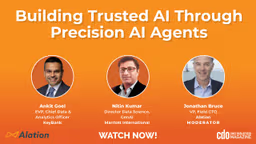Branded Content
A Guide to Building a Modern Data Architecture
Written by: Shayde Christian | Chief Data and Analytics Officer, Cloudera
Updated 2:33 PM UTC, Wed December 4, 2024

Adopting modern data architecture is a matter of necessity.
With the volume and complexity of data expanding exponentially, data estates are sprawling over a multiplicity of environments. Most organizations operate multiple data environments in multiple form factors, including cloud, data center, and hybrid cloud (which is trending multi-cloud). Only modern data architecture can unify such disparate data for data-driven innovation and real-time, cross-domain insight generation.
Modern data architecture is a layer of frameworks and systems that allow organizations to store, analyze, and grant data access seamlessly to authorized employees, making organizations more agile and efficient through stronger data management. Adopting modern data architecture is a matter of urgency.
Some assimilate the word “modern” with “future” or “emerging” but it also denotes “recency,” meaning that failing to stay modern portends getting left behind. Without modern data architecture, agility and flexibility get lost, making scalability missions impossible, and placing organizations at a competitive disadvantage.
Thankfully, a hybrid approach facilitates a gradual transition to modern data architecture which begins with the thoughtful assessment and adoption of applicable layers of modern data architecture — unified data fabric, open data lakehouse, and scalable infrastructure.
Store and analyze data through an open data lakehouse
An open data lakehouse architecture layer is a logical place to start. Data streamed from endpoints on the edge, sourced from business applications, and procured externally, must be collected, stored, and accessed for data-driven decision-making. Open data lakehouses serve that purpose, bringing together high-volume, high-complexity data in one location where it can be turned into insight and value in a safe and compliant manner.
They are often business domain-specific, but they could be region-centric if compliance dictates it. Open data lakehouses are built on various technologies and infrastructures: BigQuery on GCP, Azure ADLS+Synapse, and Cloudera on cloud or on-premises (with the unique differentiator being that workloads can be built just once and run anywhere).
The open data lakehouse architecture affords flexibility and scalability, and if architected in a centralized manner, it can eliminate data siloes and inaccessibility.
Break through silos with data fabric
A data fabric facilitates the understanding of the underlying data on which open lakehouses are built. It is an architecture that provides a scalable, automated approach to unlocking data from any and all data sources on any and all infrastructures. A fabric brings that data together, describes it in terms of its relevance and value to the organization, and makes it available to those who need it in a self-servant, safe, and compliant manner.
This layer truly democratizes data access, eliminating the need for end users to ask IT if the data they need can be made available for their use cases.
A (meta)data catalog is key. It unifies the fabric and the lakehouse. Regardless of the proliferation of lakehouses or underlying infrastructures, it provides a single pane of glass from which to both manage and discover data assets across the enterprise, building trust through transparency.
Use data mesh to boost agility and flexibility
Data mesh is not so much an architecture as it is a framework, a guiding principle for decentralization, but not for decentralization of data. It is an organizational approach to the people and process components employed to execute and operate modern data architecture.
A data mesh enables each domain to own, manage, and deliver their data as a product in the way they see fit. Domain owners, not centralized organizations, select their own tools and dictate the pace at which products are engineered.
For years, large global brands have felt the frustration and futility of trying to meet increasing demand for timely data management and data access across the enterprise. Scaling resources to meet the demand resulted in diminishing returns, and as a result, could not be sustained. Data mesh concepts arose to address the gap.
Domain owners know their data best. That not only increases the likelihood that the right data will be productized, but that it will be more fit for purpose, and that insights will be extracted more readily by the organization as a whole.
A modern data architecture enables organizations to improve data management, which is a necessity in today’s data-driven world. It not only makes organizations more adaptable to technologies on the horizon, but it allows them to improve efficiency today. The ability to better manage critical data and employee authorization under one simple view makes enterprises more efficient, compliant, and secure regarding data management.
To learn how you can implement a modern data architecture with Cloudera, click here.
About the Authors:
Shayde Christian is Chief Data and Analytics Officer at Cloudera. He guides data-driven cultural change for Cloudera to generate maximum value from data. Christian enables customers to get the absolute best from their Cloudera products such that they can generate high-value use cases for competitive advantage.
Previously a principal consultant, Christian formulated data strategy for Fortune 500 clients and designed, constructed, or turned around failing enterprise information management organizations. He enjoys laughter and is often the cause of it.
Wim Stoop is senior director of product marketing for Cloudera. In this role, he leads the marketing direction and strategic vision for Cloudera’s mission to let organizations turn data into business value at scale. Prior to Cloudera, Stoop spent more than 17 years helping blue-chip companies such as IBM, BP, and HSBC solve their most data-intensive challenges in the context of their business objectives and usage scenarios.
Stoop is a regular speaker at industry events where organizations are deciding and defining their big data strategy and direction. He holds a degree in Chemical Process Technology from the Eindhoven University of Technology in The Netherlands.





